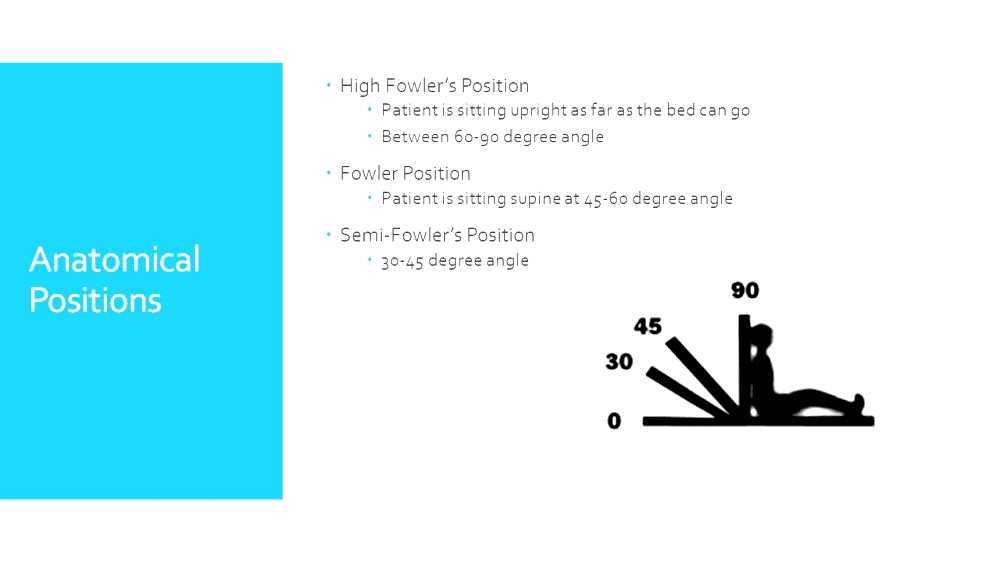

These findings may be useful in reducing side effects related to oxygen toxicity. When comparing the position of semi-fowler with each of the lateral positions, the positioning of semi-Fowler was found to be beneficial to improve tidal volume and oxygenation in patients ventilated mechanically in ICU. It should be noted that the use of nitrous oxide with a patient in this position should be avoided since the size of the bubble increases if a venous air embolism occurs. There is greater potential for airway loss, nerve damage, facial / gloss edema, Pneumocephalus, and the risk of quadriplegia increases in patients.

It can increase the presence of air or gases inside the skull, can cause ocular compression, cervical tetraplegia, edema or macroglosia. DisadvantagesĪmong the disadvantages of the semi-Fowler position are postural hypotension, where there is a decrease in the return of blood to the heart (a situation that can be avoided by gradually changing the position of the patient).Ĭerebral perfusion also decreases and there may be a risk of venous embolism, especially cranial. AdvantageĪmong the advantages of this position we also find that the patient is in better surgical exposure, contributes to blood circulation and drainage of cerebrospinal fluid, and has a possible advantage in improving hemostasis. Pressure points in the semi-Fowler position include the occiput, scapula, elbow, sacrum, heels. In nervous problemsĪffected nerves may include sciatica (lack of flexion in the knees) and cervical nerves. It increases lung capacity with higher compliance, decreases pulmonary arterial pressure with increased pulmonary vascular resistance. The patient may develop a decrease in mean arterial pressure and central venous pressure, altered venous return of reduced stroke volume and decreased cardiac output (by 20%). Physiological influences of various positions should be understood to improve patient care in the clinical setting. However, the effects of slight postural differences on Fowler's position on cardiovascular regulation and hemodynamics have not been investigated. A cross-sectional study of hypertensive patients found that tension was low compared to supine tension in intensive care patients. This position also helps control hemodynamics and facilitate breathing and daily activities, such as eating or talking to fragile patients. The position can also help with decompression of the chest. This position is also used to implement oral and gastric feeding tubes to the patient. This position allows for improved breathing due to chest expansion and oxygenation, it can also be implemented during episodes of respiratory distress. This position allows feeding patients who can not do it by themselves, collaborates with the nasogastric feeding and also facilitates that the thorax expands and helps the postural changes. The advantages of this position include facilitating drainage of blood to the brain. The chin should be 1-2 finger widths from the chest Otherwise, this position may tighten the vertebra C5. In the semi-Fowler position, patients are placed in a seated position with the head of the bed 30-90 degrees above the horizontal plane. The risk of nerve damage is high And nerve injuries are usually one of the most common causes of demands related to surgery.
FOWLERS POSITION FULL
Surgical procedures requiring the use of anesthesia (both general and conscious sedation) make patients vulnerable to potential injuries so that each position carries some degree of risk, which is magnified in the anesthetized patient.Ĭonsequently, medical personnel should provide full patient protection by providing specific care especially when there are bony prominences, joint position, and portions dependent on the patient's body.Īlthough Fowler positions are considered non-surgical, they are also used during very specific surgeries.

Fowler's position is the patient's standard position. George Ryerson Fowler, a surgeon in New York City. They are also very important for nurses and medical professionals to do their job better and treat patients.Īll Fowler positions were named after Dr. They are used to help the patient with basic bodily actions.


 0 kommentar(er)
0 kommentar(er)
